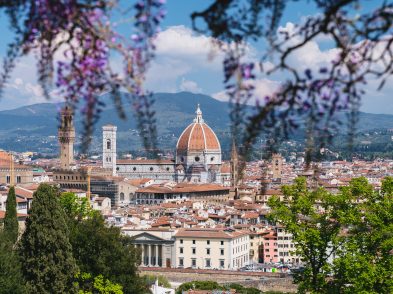They are on almost every block, a reminder of Florence’s medieval legacy, yet many were created in the nineteenth and twentieth century: the city’s iron horse hitches reveal a little-known aspect of Florence’s architectural history. Silent yet present, they guard the streets, as they have for centuries.
In Florence, all ironwork on the façade of a building is referred to as ferri (irons). This applies not only to horse hitches, but also to ironwork used for banners, flags and other utilitarian purposes.
I became so intrigued with the horse hitches, ferrous witnesses to Florence’s past, that I wrote I Cavalli di Firenze (The Horses of Florence), which focuses solely on the iron hitches at the street level of a palace’s façade. Though easy to ignore amid Florence’s many splendors, close attention reveals that these ferri possess a unique charm. Often surmounted with stylized images of lions, cats, dragons, horses or other fictitious animal-like forms, their appearance can be surprisingly modern, humorous and compelling. This is what struck me about them and inspired me to photograph each one I could find.
Since 2008, I have combed the streets of Florence to capture the ferri, returning each year to locate and document them systematically. In the process, I discovered more than 60 variations of sculpture in iron, a creative yet crude form of early Italian folk art.
Subsequent research on the ferri—especially information provided by Claudio Paolini of the superintendency for architectural heritage for Florence—revealed that they have a very interesting history that had not previously been told.
Initially devised in the thirteenth century to tie horses to the wall of a public building or private residence, the ferri were gradually transformed from a functional component to a decorative element on a palace’s façade. As medieval ornament went out of fashion a few centuries later, many ferri were removed; those that remained were neglected or damaged.

In the nineteenth century, interest in medieval architecture returned in full force. Gothic Revival and pre-Raphaelite movements spurred a renewed appreciation for the art and architecture of early Florence. This appreciation led to efforts both to restore that which had been lost and to ornament new buildings in neo-Gothic style.
The Americans and northern Europeans who migrated to Florence during that period were especially taken with this fashion. They were a primary force in recreating the harmony and beauty of an ‘authentic’ fifteenth-century city, including the restoration of medieval and Renaissance ironwork.
These expatriates purchased or rented the family palaces of impoverished Florentine noblemen and then embellished them. They constructed new villas in Gothic style in the Florentine countryside, using ferri as a decorative architectural element into the twentieth century. Several antiquarians restored Florentine buildings, including palazzo Davanzati, to set up shop and show their wares in an elegant environment.
Ferri were recreated in as near to their imagined ‘original’ style as possible and returned to their place on the façades. The expatriates were enraged by the destruction of the medieval ghetto to make room for the nineteenth-century piazza della Repubblica. Their determination to rescue Florence from such architectural ‘barbarisms’ led to a golden age for iron factories, kept busy not only restoring older buildings but also designing ironwork in Liberty style.
It is not that difficult to discover the history of almost every Florentine building adorned with ferri, but it is almost impossible to tell whether they are contemporaneous with that building or were added at a later date. Those in the courtyard of the Bargello seem to be the oldest, but very little restoration work is documented. Further, the extent to which ferri wrought in the late nineteenth or early twentieth century were derived or fashioned after what had existed previously is unknown. For the most part, the actual age of each ferro can only be surmised, since iron corrodes quickly and cobwebs form, giving the appearance of great age.
As I photographed the ferri, I realized that passers-by rarely notice them. Puzzled tourists occasionally gathered around me to see what I was looking at. In one case, a Florentine shop owner told me that although his store had been in that location since 1996, he had never noticed the stylized face on the ferro attached to its façade. Yet the ferri deserve to be appreciated and conserved. Many are broken and some are defaced by graffiti. Ironically, when Florentines do notice them, they sometimes adopt them for practical purposes. These can strike the observer as almost comical: to attach a lock, latch a door or to hang a sign or a menu.
The ferri remain on the streets of Florence as architectural ornament, a testament to the passage of time and a reminder of an early age. They demonstrate that Florentines have long been dedicated to imbuing the most utilitarian items with beauty. They are worthy of greater attention, and my hope is that my book will encourage that.




